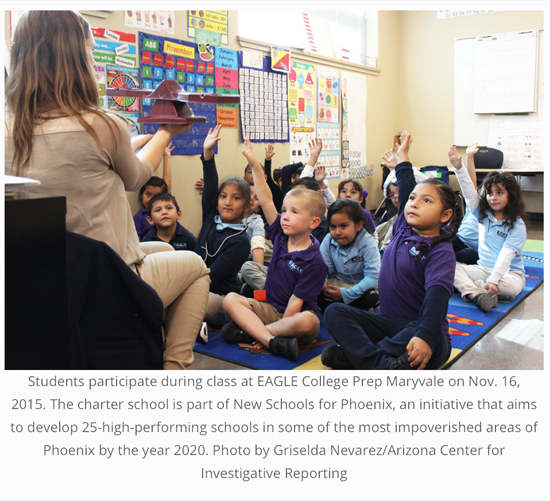 By Griselda Nevarez and Evan Wyloge | Arizona Center for Investigative
By Griselda Nevarez and Evan Wyloge | Arizona Center for Investigative
Two decades after Arizona helped pioneer the charter school movement, enrollment data show the schools don’t match the school age demographics of the state and, in many cases, their neighborhoods. White – and especially Asian – students attend charter schools at a higher rate than Hispanics, who now make up the the greatest portion of Arizona’s school age population.
Hispanic students account for 44 percent of all students in Arizona, but they make up just 36 percent of charter school students. White students, who make up 40 percent of the school age population, account for 48 percent of all charter students.
“The mission of public education is to give every child in our state the equal opportunity to excel to the maximum of their capabilities,” said Tim Ogle, executive director of the Arizona School Boards Association. “When you have disparities of opportunity, you are systemically inhibiting some groups over other groups through public policy, and that’s just inherently wrong.”
The Arizona Department of Education hasn’t conducted a formal analysis of the school enrollment demographics, but the agency’s spokesman, Charles Tack, said they’re anecdotally aware of the disparity, and that the data “confirms that there is work to be done.”
Researchers, education policy experts and school administrators say the disparity could be explained by a number of factors. The lack of transportation at some charter schools can provide a barrier, or an “information gap” about the charter school system may affect how minorities choose to participate in it. Parents might simply choose schools where the ethnic profile more closely matches their family.
Arizona lawmakers established charter schools in the 1990s so that parents could send their children to schools specializing in rigor, the arts or Montessori teaching methods, to provide an education more tailored than what was traditionally available in public schools.
Today, roughly 17 percent of all students in Arizona’s public schools attend a charter — about triple the national average of 5 percent. Only the District of Columbia has a greater portion of charter school students.
Charter schools here receive state funding based on enrollment, and operate independent of school districts. They’re either run by non-profit or for-profit groups. In fiscal year 2014, the state provided $8,041 per student to charter schools, compared to $9,096 per student to district schools. District schools generate additional funding through voter-approved bonds and overrides. These funding streams aren’t available to charters, but they can raise more money through donations and grants.
Arizona’s open enrollment law allows parents to send their children to any school they choose – district or charter – even if it’s outside their neighborhood, provided there is room.
The Arizona Center for Investigative Reporting analyzed school enrollment demographics for public schools in Arizona, categorizing each and then comparing it to the demographic data within the surrounding communities and schools within a 10 mile radius. The analysis provides a snapshot of Arizona school demographics from 2014, the most recent statewide data available. It did not look at elementary schools and high schools separately, because schools have a variety of different grade levels, and ethnicity data is provided only by school, not grade level and school.
While there are exceptions, when charter schools are compared to their neighborhoods and to other nearby schools, data shows that they are more likely to be whiter than the surrounding area, while district schools tend to over-represent Hispanic students.
As a portion of each ethnicity’s school age population, one of every six Hispanic students in Arizona attends a charter school, but for white students, it’s one in every four. Among Asians, it’s one of every three, and for Native Americans it’s one in 10. The trend is more pronounced for charter schools located in more rural communities with fewer school choices, and among specific types of charters.
Schools with high levels of ethnic disparity are darker. Click on schools to see demographic information for the school, the census tract and district schools within 10 miles.
In both “rigorous” and “progressive” charter schools, more than half of the student population is white, and less than 30 percent is Hispanic. Alternatively, among “at-risk” charter schools, which cater to students at risk of failing out of school, Hispanics make up an overwhelming majority of the students, with white students making up less than 20 percent.
In areas such as Safford, Yuma, Bullhead City and Prescott, where there are fewer district and charter schools, the overall ethnic composition of charter schools skews further white than the state average. In the Tucson area, almost every school with a high ethnic disparity is a charter school.
A 1999 study of Arizona’s then-nascent charter school system found similar trends.
Eileen Sigmund, president and CEO of the Arizona Charter Schools Association, said diversity is good for schools but that the figures shed light on a need for greater awareness of education options.
“Results for students are better if there’s mixed demographics,” Sigmund said. “That is the research and my leaders know it, and they’ll often ask me, ‘How do I get more of a mixed demographic? I’m concerned that I’m not able to serve as many students as I can.’”
Jonathan Butcher, education director for the Goldwater Institute, said charter schools shouldn’t be criticized for their student demographics because being diverse wasn’t the initial goal.
“Yes, we want (charter schools) to serve diverse populations, but I think it’s unfair to criticize them for not doing something that isn’t part of the main goal that they were set up to do,” Butcher said. “Their goal was to give parents more options and to improve student achievement. That’s what they were set up to do.”
Charter School Types:
Rigorous: tailored for academically advanced students and focus on preparing students for college
Progressive: focus on serving the needs of the “whole child” and cultivating each student’s unique strengths, also known as the Montessori method of teaching
Arts: explicitly focus on the arts
At-risk: serve students who didn’t do well in traditional school settings and are behind on credits
Disabilities: focus on educating students with disabilities
Virtual: offer online courses
General: didn’t fall into any other category
Heritage Academy, a general charter school in downtown Mesa, has operated for more than 20 years, serving students in the Northeast Valley. It’s Principal, Earl Taylor, said students come from as far as Coolidge and North Phoenix.
That regional focus, Taylor said, complicates the issue of how his charter school’s demographics compare to the community where it’s located. Heritage Academy is 80 percent white and 14 percent Hispanic. But the school age population around the school is 61 percent Hispanic and 27 percent white. District schools within a 10-mile radius have nearly equal portions of white and Hispanic students.
“It may be comparing apples to oranges when trying to compare local demographics to a school with more of a regional market,” Taylor said. “As with all public schools, our school is open and welcomes all families including those in our surrounding neighborhoods.”
The school doesn’t have an organized recruiting program, Taylor said, and most parents learn about the school through word-of-mouth. The school appeals to parents because of its strong academic program, behavior standards and mission to teach students “the ideals and values that made America great,” he said.
Timo and Colette Hansen have three children enrolled at Heritage Academy. Although the school has a carpool program, the Hansens drive their kids to and from school. It’s roughly 20 minutes each way from their north Mesa home, adding hours of driving each week.
Each of their six children, including the three currently enrolled at Heritage Academy, have attended both charter and district schools. Hansen handpicked each based on her children’s unique needs.
Colette Hansen said Heritage stood out because it pushes students academically. She also felt that the school’s small size – it serves 650 students in grades 7-12 – would be a better fit for her children.
“My kids can come to school and feel accepted,” she said. “It’s been interesting to see how they are able to function and grow in an environment where they feel comfortable and safe.”
New School for the Arts and Academics in Tempe also has a student body that’s whiter than the surrounding area. Sixty-nine percent of the school’s students are white and 17 percent are Hispanic. The school is located in a neighborhood that’s only 10 percent white and 67 Hispanic. District schools within a 10-mile radius have, on average, a student population that’s 31 percent white and 51 percent Hispanic.
Katy Cardenas, executive dean of the Tempe charter, said in an email that the school mainly recruits through word-of-mouth among families and artists, and that it serves students from roughly 22 different zip codes.
“Our families come from everywhere; we have families from Avondale, Maricopa, Queen Creek,” Cardenas said. “Our families choose us for the comprehensive art, both visual and performing, and college prep program.”
Some charter schools, such as Sonoran Science Academy, a rigorous school in Phoenix, show the opposite, with greater diversity than the surrounding area. Forty-seven percent of the school’s student body is black, 30 percent is white and 17 percent is Hispanic, compared to the surrounding area that is 6 percent white, 10 percent black and 78 percent Hispanic.
The school focuses on science, technology, engineering, and math (STEM) as well as college preparation. It’s located in a former refugee resettlement area and over time has attracted refugee families through word-of mouth. Today, one-third of its students speak English as a second language and more than 20 languages are represented in the school.
The BASIS charter schools, which consistently rank among the highest-performing public schools in the country, are particularly popular among Asian families. Nearly 28 percent of all BASIS students are Asian, although Asians only make up about 3 percent of the state’s K-12 public school students.
BASIS Chandler has the greatest percentage of Asian students of any BASIS school. Sixty-eight percent of the school’s population – 497 out of 731 students – are Asian, though the surrounding neighborhood is only 5 percent Asian. Overall, the combined student population at the BASIS schools is 57 percent white and 11 percent Hispanic.
BASIS representatives didn’t respond to repeated requests for comment, but said in an email that BASIS is “incredibly proud of the diverse nature” of its student population.
Andrew Morrill, president of the Arizona Education Association, said public schools have historically had a strong connection to the community in which they’re located and that it’s difficult for charter schools to build that same connection when they don’t serve the students from around the area.
“When you have schools that may encourage folks of some ethnicities but not necessarily the ones in those communities, how connected is that school to the local neighborhood?” Morrill said. “What really is that charter school then to the local community?”
Is student diversity in Arizona’s public schools important to your community? We want to hear from you through a partnership between AZCIR and the Public Insight Network Bureau:
Researchers at the Civil Rights Project at the University of California, Los Angeles, found in 2009 that access to charter schools and other school choice options are constrained by a number of factors, including socioeconomic status, language barriers and parents’ social networks.
Their research found that charter schools that don’t provide transportation create a barrier for students whose parents aren’t able to arrange alternative transportation.
In Arizona, neither charter nor district schools are required to provide transportation and only district schools get funding to pay for it. However, charter schools get “additional assistance” from the state, which is included in the overall per pupil funding, that can be used flexibly, including to pay for transportation.
A 2014 national Phi Delta Kappa/Gallup poll found that most parents don’t have a clear understanding of what charter schools are or how they operate. Half of the poll respondents said they thought charters were not public schools. Forty-eight percent thought they can teach religion. The majority believed charter schools can charge tuition and admit students based on academic ability.
Chicanos por la Causa (CPLC), a nonprofit that provides social services primarily to Arizona’s Hispanic community and runs two charter schools, conducted a small focus group with 22 Hispanic parents in Phoenix that produced similar results.
Magdalena Verdugo, CPLC vice president of education, said most parents didn’t know they could send their children to charter schools, saying “the perception was that charter schools were private.”
Hispanic parents whose children are enrolled in charter schools believe charter schools are better than district schools because of their small and organized classrooms, disciplined students, secure environment and challenging academic curriculum.
For the most part, Hispanic parents who don’t have children enrolled in charter schools had a positive view of charters. Spanish-speaking Hispanic parents, however, perceived charters as the last resort for students who were expelled from other schools. Some also thought charters are religious schools.
Spanish-speaking parents were also unaware of school choice and thought low-income students don’t have the right or ability to attend a high-quality school, regardless of whether the school is a district or charter.
The lack of transportation presents the biggest barrier for Hispanic parents who want to enroll their children in charter schools, Verdugo said. For Spanish-speaking parents, it’s the inability to communicate with charter school staff in their native language.
CPLC plans to create a program to raise awareness of charter schools and school choice options among primarily low-income Hispanic families in Phoenix. The grant-funded program will include attending community events and meeting with parents to educate them about school choices.
Demonstrators at a school choice rally held at the Arizona Capitol displayed various signs supporting both charter and district public schools in Arizona on Friday, Jan. 29, 2016. Photo by Evan Wyloge/Arizona Center for Investigative Reporting
“If I can teach one parent about what a charter school is, their options and how they can navigate the education system, my hope is that that parent is going to go to their neighbor and spread that information,” CPLC’s Verdugo said. “Word of mouth is huge in our community.”
Yesenia Fitzhugh, principal of EAGLE College Prep Maryvale, a rigorous charter school in a heavily Hispanic neighborhood in Phoenix, said she recruited students door-to-door, when it opened in 2014. She said some Hispanic parents thought charter schools were private and charged tuition, but that those misconceptions were easily dispelled.
The school’s demographics match closely to its neighborhood. The school is 88 percent Hispanic and 2 percent white, while the neighborhood is nearly 89 percent Hispanic and 5 percent white.
David Garcia, an Arizona State University professor who also ran unsuccessfully for superintendent of public instruction in 2014, conducted a study in 2008 that tracked individual students moving from public schools to charters from 1997 to 2000.
White students left district elementary schools to enter charter elementary schools that were, on average, 10 percent more white. Black elementary school students entered charters that were, on average, 29 percent more black than the district schools they left. For students leaving district high schools, however, both white and black students entered charter schools that had similar percentages of white and black students.
Students participate during class at EAGLE College Prep Maryvale on Nov. 16, 2015. The charter school is part of New Schools for Phoenix, an initiative that aims to develop 25-high-performing schools in some of the most impoverished areas of Phoenix by the year 2020. Photo by Griselda Nevarez/Arizona Center for Investigative Reporting
Students participate during class at EAGLE College Prep Maryvale on Nov. 16, 2015. The charter school is part of New Schools for Phoenix, an initiative that aims to develop 25-high-performing schools in some of the most impoverished areas of Phoenix by the year 2020. Photo by Griselda Nevarez/Arizona Center for Investigative Reporting
Native Americans across all grade levels chose to attend charter schools that had a higher concentration of Native Americans than the district schools they exited. Hispanic elementary school students were the only group that didn’t self-segregate into charter schools with a higher percentage of students from the same ethnic group.
“If you look around, we spend a lot of time with people like ourselves,” Garcia said. “And the question I have is, why then when it comes to sending your kids to school, what makes us think we would do anything different? That is, to me, a legitimate challenge when we stand up and say we should have more integrated schools.”
At least three states have laws in place that attempt to ensure charter schools are more integrated and reflect the communities in which they’re located.
North Carolina mandates charter schools to “reasonably reflect the racial and ethnic composition” of the community it serves within a year of opening. South Carolina requires charter schools to have the same racial and ethnic composition as the local school districts where they’re located. And in Nevada, the racial and ethnic composition of a charter school cannot differ by more than 10 percent from that of the surrounding public schools.
All three states require charter schools to provide open enrollment to any student in the state.
Eileen Sigmund of the Arizona Charter Schools Association said charter school leaders are doing what they can to expand into minority-heavy areas. The association has teamed up with a number of community groups and foundations to expand charter schools to neighborhoods that are predominately Hispanic through an initiative called New Schools for Phoenix.
Formed in 2013, the goal of New Schools for Phoenix is to develop 25 high-performing charter schools in some of the most impoverished areas of Phoenix by the year 2020. So far, 12 schools have opened, including EAGLE College Prep Maryvale. Two more are planned to open this year.
“We’re trying to make sure we have an excellent public school for every student in every neighborhood,” Sigmund said.











